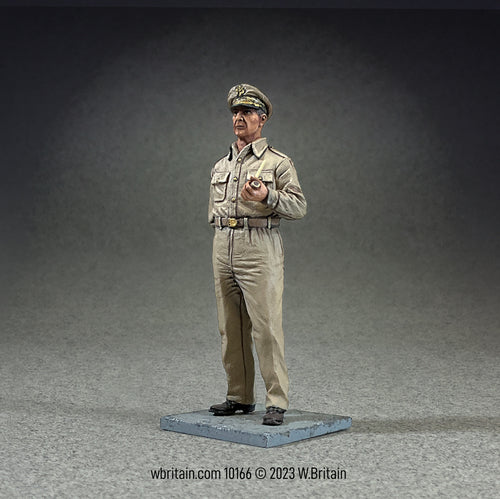- Continue Shopping
- Your Cart is Empty
25212 - German Artillery Officer on Field Phone, 1941-45
$ 48.00
NEW! IN STOCK!
German Artillery Officer on Field Phone, 1941-45
This artillery officer uses the feldfernsprecher 33 (FF33) field telephone of the German military forces of WWII. It was introduced in 1933 as a modern replacement for the older styles dating from the First World War. Although it was a general purpose field telephone designed for wired communications, it could be connected to various radio sets to act as a remote handset. The complete telephone weighed almost 13 pounds and was housed in a bakelite case carried on a leather shoulder strap. Each telephone unit included a press to talk (PTT) handset, switchboard patch cable, generator crank, 1.5 volt battery, and internal framework for the telephone components. The simplest set up was point to point, requiring two sets, but several could be hooked up to communicate with a command post, and up to 20 units could be linked by a switchboard. Headphone (kopfhörer) and throat microphone (kehlkopfmikrofon) could be used with the telephone when it was used by switchboard operators.
Related Items
10166 - U.S. General Douglas MacArthur, 1945
$ 48.00
NEW! IN STOCK! U.S. General Douglas MacArthur, 1945 Youngest son of a Union Civil War General and Medal of Honor recipient, Douglas MacArthur was himself nominated for the Medal of...
10167 - U.S.N. Admiral Chester W. Nimitz, 1944-45
$ 48.00
NEW! IN STOCK! U.S.N. Admiral Chester W. Nimitz, 1944-45 Chester William Nimitz entered the Naval Academy in 1905 and was an excellent student, graduating with distinction. Afterwards he joined the...
10168 - U.S.N. Commander Lyndon Baines Johnson, 1942-45
$ 48.00
NEW! IN STOCK! U.S.N. Commander Lyndon Baines Johnson, 1942-45 In 1938, Lyndon Baines Johnson was serving in the United States Congress. While a U.S. representative, he was appointed lieutenant commander...
10169 - U.S.N Lieutenant Jimmy Carter, 1948-51
$ 48.00
NEW! IN STOCK! U.S.N Lieutenant Jimmy Carter, 1948-51 James Earl Carter graduated from the U.S. Naval Academy in 1946 with distinction. When the nuclear-powered submarines came on-line, Carter was anxious...














